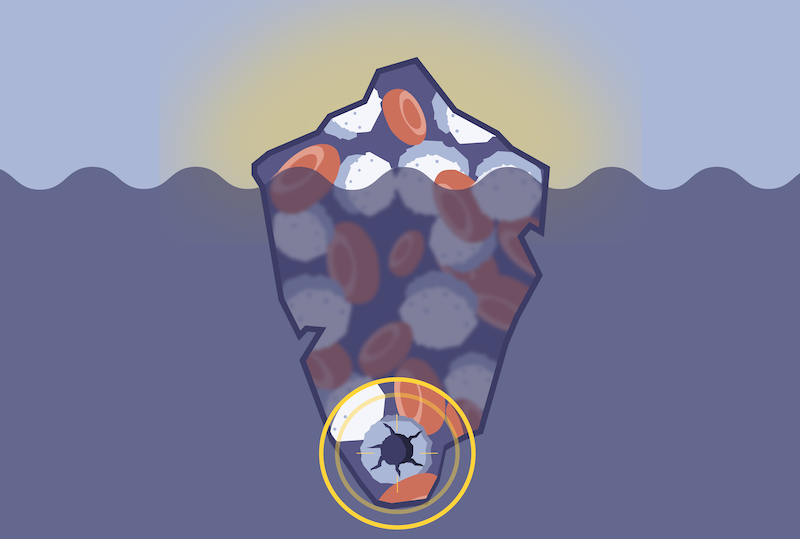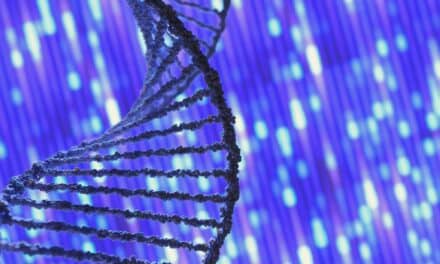Summary:
Next-generation sequencing (NGS)-based measurable residual disease (MRD) testing offers unprecedented sensitivity and breadth in detecting low-frequency leukemic clones, enabling earlier relapse prediction, precision therapy, and deeper understanding of clonal evolution in hematological malignancies like AML.
Takeaways:
- Enhanced Sensitivity & Breadth: NGS MRD can detect ultra-low variant allele frequencies (≤0.01%) and monitor multiple mutations simultaneously, including challenging ones like FLT3-ITDs, outperforming conventional methods.
- Clinical & Research Impact: NGS-based MRD serves as a critical biomarker for relapse risk, therapeutic response, and clonal dynamics, supporting precision treatment decisions and near real-time disease surveillance.
- Transforming Drug Development: Recognized by regulatory bodies, MRD is emerging as a surrogate endpoint in clinical trials, accelerating the development and validation of targeted therapies in hematological cancers.
By Graham Speight, PhD
In hematological malignancies, achieving complete morphological remission does not always equate to disease control. Residual leukemic clones can persist at extremely low levels, below the threshold of conventional detection, and their presence is associated with increased risk of relapse and poorer long-term outcomes.
This challenge is especially evident in acute myeloid leukemia (AML), where approximately 50% of patients who initially achieve complete remission will eventually relapse, thereafter facing a poor prognosis1. Detecting these low-frequency variants with sufficient sensitivity and specificity is critical to enabling earlier intervention and more effective post-treatment surveillance.
However, disease monitoring is often hampered by the substantial genomic heterogeneity and clonal evolution typical of hematological malignancies. Conventional analysis methods such as flow cytometry and single-target PCR frequently lack the resolution or breadth of targets to identify the low-frequency mutations that can drive recurrence.
Next-generation sequencing (NGS)-based measurable residual disease (MRD) assessment directly addresses these limitations. By enabling the simultaneous detection of multiple mutations at ultra-low frequencies, NGS MRD can be leveraged for measuring treatment response, predicting relapse and informing precision therapy. Its broad genomic coverage also offers deep insights into disease biology and evolution.
A Critical Biomarker for Relapse and Response
In light of the challenges facing traditional disease assessment, MRD has emerged as a clinically and biologically important biomarker, whereby the detection of disease-associated variants would be assessed as being “MRD-positive”. Rather than relying solely on morphological assessment, MRD provides dynamic insights into the changing genomic landscape of disease that can be harnessed to inform the treatment course. Studies have consistently demonstrated that MRD positivity in hematological malignancies correlates with significantly poorer outcomes, such as shorter relapse-free and overall survival2–4.
As a biomarker, MRD can function as an early warning system, detecting signs of relapse before other measurements of progression, such as morphological assessment. From a therapeutic perspective, it provides an objective indicator of treatment efficacy. Repeated MRD monitoring can also detect clonal shifts, e.g., the emergence of resistant subclones or a new disease-associated clone, that may inform therapeutic strategy.
However, MRD’s value has historically been constrained by technical limitations. Flow cytometry, while widely used, lacks standardization and is vulnerable to subjective gating strategies. PCR-based approaches offer greater sensitivity but only detect a limited subset of mutations per analysis, making it challenging to account for the clonal heterogeneity and evolution that characterizes diseases like AML.
NGS-based MRD testing empowers researchers and clinicians with multi-target detection at ultra-low variant allele frequencies (≤0.01% VAF), it supports robust, scalable MRD analysis that can adapt to the complexity of haematological disease biology. Its ability to detect and track high-risk mutations has important implications for prognosis and therapeutic targeting5.
MRD: Detecting Challenging High-Risk Mutations
Among the many high-risk mutations relevant to MRD monitoring in hematological malignancies, internal tandem duplications in the FLT3 gene (FLT3-ITDs) represent a key challenge. FLT3-ITDs occur in approximately 25–30% of AML cases and are associated with a higher risk of relapse, reduced overall survival, and resistance to conventional chemotherapy6.
FLT3-ITDs are difficult to detect reliably using traditional PCR-based MRD assays. Their variable size, location, and sequence complexity can hinder amplification, particularly in longer or atypical duplications. This raises the risk of false-negative results—especially in the MRD setting, where detection sensitivity is paramount.
By contrast, NGS-based MRD assays offer the resolution and flexibility needed to overcome these technical barriers. For example, in clinical research settings OGT’s SureSeq Myeloid MRD Panel* has been designed to detect 45 disease-associated exons from 13 genes, including FLT3-ITDs, without length restriction, enabling robust identification of all disease-relevant variants in a single assay. Its analytical sensitivity extends down to 0.01% VAF, allowing detection of variants that would be missed by less sensitive techniques.
NGS-based MRD testing therefore supports a more comprehensive picture of disease dynamics. Unlike fixed-target methods, NGS panels can be customized to include genes and mutations most relevant to a particular disease subtype or for sample stratification population. This flexibility ensures optimal mutation coverage for diverse scenarios—from understanding hematological disease with complex genomic landscapes to investigating the mechanisms of relapse.
By tracking co-occurring mutations, e.g. FLT3 (both tyrosine kinase domain and ITDs), NPM1, IDH1 and IDH2 clonal evolution can be better understood, allowing the identification of resistance mechanisms, and understanding their impact of disease treatment. This multi-dimensional insight is critical in a disease setting where relapse often arises not from a single dominant clone, but from a shifting, genetically diverse population.
A Near Real-Time Monitoring Platform for Precision Therapy
NGS-based MRD analysis is not only redefining how we measure treatment response in haematological malignancies—it’s transforming how we act on it. With its ability to sensitively and specifically track multiple leukemic mutations across timepoints, NGS enables clinicians and clinical trials to observe the molecular effects of therapy in near real time.
This dynamic, high-resolution view offers major advantages in both clinical and research settings. In care settings, it can help determine whether a patient is responding to therapy or requires an altered course—for example, identifying those who might benefit from maintenance regimens, allogeneic transplantation, or molecularly targeted agents. In early-stage clinical trials, it can provide early readouts of therapeutic impact, helping researchers understand which mutations are being cleared and which persist or emerge under selective pressure.
Crucially, this molecular resolution extends beyond a binary positive/negative result. By enabling the detection of minor, co-occurring, or emerging clones, NGS MRD provides a fuller picture of clonal evolution that informs truly personalised disease management.
Driving Innovation in Trials, Drug Development and Translational Research
The value of MRD as a biomarker now extends well beyond risk stratification or routine monitoring. In hematological malignancies like AML, MRD is increasingly recognized as a surrogate efficacy-response biomarker in clinical trials—offering a practical and timely alternative to traditional endpoints like overall survival7.
This is particularly relevant in the context of novel agents and targeted therapies, where early insights into molecular response are critical for evaluating therapeutic impact and accelerating development timelines. MRD negativity, when sustained, is increasingly correlated with improved clinical outcomes, making it a compelling candidate for regulatory consideration in expedited approval pathways.
Regulatory agencies including the FDA and EMA have acknowledged MRD as an exploratory or supportive endpoint in AML trials8, and validation efforts are ongoing to establish standardized thresholds and workflows. By providing high-sensitivity, multi-target detection, NGS-based MRD platforms have the potential to offer a robust framework for generating reproducible, regulator-ready data that reflects the true biological response to therapy.
MRD is shaping the future of precision trial stratification—enabling enrollment based on molecular remission status or clonal architecture. This allows for better targeting of therapies, more efficient resource allocation, and greater confidence in interpreting trial outcomes.
Beyond its clinical applications, NGS-based MRD testing also offers profound value in advancing our scientific understanding of hematological malignancies. By capturing a broad spectrum of mutations, including sub-clonal, emerging, and non-canonical variants, NGS enables researchers to reconstruct the molecular landscape of disease evolution over time.
This granular insight can uncover mechanisms of resistance, identify new prognostic markers and highlight potential therapeutic targets that may be missed by more restricted assays. In the context of translational research and early-phase drug development, these findings help illuminate the selective pressures exerted by treatment, inform rational drug design, and support the discovery of mutation-driven vulnerabilities that can be exploited for therapeutic gain.
Changing the Game in Hematological Surveillance
As our understanding of hematological malignancies deepens, so too must our tools for detecting, monitoring, and responding to disease. MRD has become a cornerstone biomarker in this effort—providing a dynamic, quantifiable metric that accurately reflects disease burden and informs patient management.
NGS-based MRD testing builds on this foundation, offering the sensitivity, breadth, and adaptability required to match the biological complexity of conditions like AML. By detecting ultra-rare variants, tracking clonal evolution, and uncovering high-risk mutations such as FLT3-ITDs, NGS enables earlier, more informed intervention. At the same time, its integration into clinical trials is helping to accelerate the development of precision therapies and support their appropriate use in clinical practice.
As the clinical and regulatory landscape continues to evolve, NGS-based MRD is not simply a technical upgrade—it represents a fundamental shift toward more proactive, personalized and data-driven hematological care.
Featured Image: NGS-based MRD reveals the hidden genomic landscape of residual disease, detecting low-frequency variants missed by conventional methods. Image: OGT
ABOUT THE AUTHOR

Graham Speight, PhD, is executive vice president of Research and Development at OGT, where he leads the development of genomic solutions for oncology and molecular diagnostics.
*SureSeq™: For Research Use Only; Not for Use in Diagnostic Procedures.
References
- Li, Y. et al. NGS-defined measurable residual disease (MRD) after initial chemotherapy as a prognostic biomarker for acute myeloid leukemia. Blood Cancer J 13, (2023).
- Szalat, R., Anderson, K. & Munshi, N. Role of minimal residual disease assessment in multiple myeloma. Haematologica 109, 2049–2059 (2024).
- Ravandi, F., Walter, R. B. & Freeman, S. D. Evaluating measurable residual disease in acute myeloid leukemia. Blood Adv 2, 1356 (2018).
- Abou Dalle, I., Jabbour, E. & Short, N. J. Evaluation and management of measurable residual disease in acute lymphoblastic leukemia. Ther Adv Hematol 11, 2040620720910023 (2020).
- Short, N. J. et al. High-sensitivity next-generation sequencing MRD assessment in ALL identifies patients at very low risk of relapse. Blood Adv 6, 4006 (2022).
- Kiyoi, H., Kawashima, N. & Ishikawa, Y. FLT3 mutations in acute myeloid leukemia: Therapeutic paradigm beyond inhibitor development. Cancer Sci 111, 312 (2019).
- Landgren, O. & Devlin, S. M. Minimal Residual Disease as an Early Endpoint for Accelerated Drug Approval in Myeloma: A Roadmap. Blood Cancer Discov 6, 13 (2024).
- Hematologic Malignancies: Regulatory Considerations for Use of Minimal Residual Disease in Development of Drug and Biological Products for Treatment | FDA. https://www.fda.gov/regulatory-information/search-fda-guidance-documents/hematologic-malignancies-regulatory-considerations-use-minimal-residual-disease-development-drug-and.





